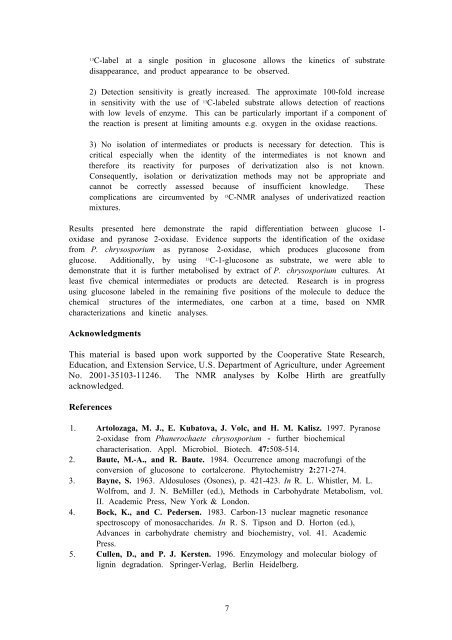View - Forest Products Laboratory
View - Forest Products Laboratory
View - Forest Products Laboratory
You also want an ePaper? Increase the reach of your titles
YUMPU automatically turns print PDFs into web optimized ePapers that Google loves.
13C-label at a single position in glucosone allows the kinetics of substrate<br />
disappearance, and product appearance to be observed.<br />
2) Detection sensitivity is greatly increased. The approximate 100-fold increase<br />
in sensitivity with the use of 13 C-labeled substrate allows detection of reactions<br />
with low levels of enzyme. This can be particularly important if a component of<br />
the reaction is present at limiting amounts e.g. oxygen in the oxidase reactions.<br />
3) No isolation of intermediates or products is necessary for detection. This is<br />
critical especially when the identity of the intermediates is not known and<br />
therefore its reactivity for purposes of derivatization also is not known.<br />
Consequently, isolation or derivatization methods may not be appropriate and<br />
cannot be correctly assessed because of insufficient knowledge. These<br />
complications are circumvented by 13 C-NMR analyses of underivatized reaction<br />
mixtures.<br />
Results presented here demonstrate the rapid differentiation between glucose 1-<br />
oxidase and pyranose 2-oxidase. Evidence supports the identification of the oxidase<br />
from P. chrysosporium as pyranose 2-oxidase, which produces glucosone from<br />
glucose. Additionally, by using<br />
13C-1-glucosone as substrate, we were able to<br />
demonstrate that it is further metabolised by extract of P. chrysosporium cultures. At<br />
least five chemical intermediates or products are detected. Research is in progress<br />
using glucosone labeled in the remaining five positions of the molecule to deduce the<br />
chemical structures of the intermediates, one carbon at a time, based on NMR<br />
characterizations and kinetic analyses.<br />
Acknowledgments<br />
This material is based upon work supported by the Cooperative State Research,<br />
Education, and Extension Service, U.S. Department of Agriculture, under Agreement<br />
No. 2001-35103-11246. The NMR analyses by Kolbe Hirth are greatfully<br />
acknowledged.<br />
References<br />
1. Artolozaga, M. J., E. Kubatova, J. Volc, and H. M. Kalisz. 1997. Pyranose<br />
2-oxidase from Phanerochaete chrysosporium - further biochemical<br />
characterisation. Appl. Microbiol. Biotech. 47:508-514.<br />
2. Baute, M.-A., and R. Baute. 1984. Occurrence among macrofungi of the<br />
conversion of glucosone to cortalcerone. Phytochemistry 2:271-274.<br />
3. Bayne, S. 1963. Aldosuloses (Osones), p. 421-423. In R. L. Whistler, M. L.<br />
Wolfrom, and J. N. BeMiller (ed.), Methods in Carbohydrate Metabolism, vol.<br />
II. Academic Press, New York & London.<br />
4. Bock, K., and C. Pedersen. 1983. Carbon-13 nuclear magnetic resonance<br />
spectroscopy of monosaccharides. In R. S. Tipson and D. Horton (ed.),<br />
Advances in carbohydrate chemistry and biochemistry, vol. 41. Academic<br />
Press.<br />
5. Cullen, D., and P. J. Kersten. 1996. Enzymology and molecular biology of<br />
lignin degradation. Springer-Verlag, Berlin Heidelberg.<br />
7
















